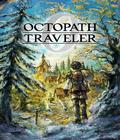Capcom has always been a big supporter of Nintendo consoles. Except for some of the more graphically intensive titles over the last console generation, almost every release from the famed developer and publisher has made an appearance on a Nintendo platform day and date with the other competing consoles. The trend has continued with the Switch 2, and Capcom has two titles for the new Nintendo platform's launch. One of those titles is Kunitsu-Gami: Path of the Goddess, a game that was released last year on other platforms.
Kunitsu-Gami takes place at the height of the feudal Japanese era on Mount Kafuku. For a while, the villages residing on the mountain have lived life peacefully, but a combination of human greed and a pillaging of resources has caused the spirits of the mountain to revolt. Demons known as Seethe have emerged from the defiled torii gates to terrorize people. The priestess of the area, Yoshiro, has been tasked with cleansing the Seethe corruption from the mountain, but the performance of her rituals has left the priestess defenseless. You play the role of Soh, a guardian spirit who has been charged with protecting Yoshiro from the Seethe as you work together to cleanse the mountain one village at a time.
The gameplay can be best described as a hybridization of different genres and mechanics. For example, protecting Yoshiro can be comparable to an escort mission, but you aren't at the mercy of an AI-controlled character who tries their best to get hurt. You can only tell Yoshiro to move forward in her path, albeit at a very slow pace, or you can tell her to stop so it falls on you whether she's in harm's way. Unlike the VIPs in other escort missions, Yoshiro has a sizable health bar so she can withstand a few hits before falling.
When it comes to attacks, the game follows a basic hack-and-slash formula, where you have two different action buttons that determine the strength of your attacks. Those can be strung together to form basic combos, which are good enough to deal with most foes. While you'll have a sword for most fights, you eventually get a bow and arrow and a different sword style, but the combo strings don't change. Unlike some recent games in the action genre, this is well suited for button-mashers. You won't lock yourself into a combo that must be finished before you can initiate another attack. Defense also plays a role in combat, but not to the degree where it is essential to parry everything to land a hit. It should also be noted that the act of dodging is mapped to clicking in the left analog stick, making it awkward to use since that isn't a common button in most hack-and-slash titles. Even with that issue, the action feels smooth to execute, so it won't take long to get the hang of things.
Strategy is the other main mechanic that the game uses. You'll spend some time freeing villagers from their corrupted state, and each villager can be assigned different combat roles, such as woodcutter, sorcerer, or archer. From there, you can position those villagers-turned-soldiers on the map, so they can be in charge of covering a small area from invading Seethe. You can change any of the villager's roles at any time, and you have to get next to them to heal them, but for the most part, each villager is skilled enough to handle some of the Seethe on their own without immediately perishing. They feel smart enough that you'll want to find and activate all of them so each stage's fights feel fair.
All of those mechanics come together in a day-night cycle that has a good rhythm. By day, you can roam around each village, freeing villagers from their corrupted state and assigning them roles and positions. You can carve out a path for Yoshiro to travel and uncover resources, like healing pods or orbs to assign roles to villagers. By night, Yoshiro stops traveling, but the fights begin, and combat never lets up until dawn breaks. Levels take more than one day to complete, so you'll several day-night cycles to finish. Neither state feels like it lasts too long, especially since you can speed up time during the day to compensate for Yoshiro's slower path progression while she dances.
As expected in adventure games, there are boss fights. They don't exist in the standard day-night cycle in Kunitsu-Gami; you'll have a moment to prepare villagers and other resources before the fight begins, but you won't get any breaks once it starts. There is a palpable difficulty spike in the boss skirmishes, and it's really noticeable when you reach the stage immediately after a boss fight and find that the battles aren't nearly as difficult. The good news is that the boss fights tend to be rather inventive and play around with the established gameplay mechanics. One fight will have you constantly firing arrows to light torches, so you can actually see the boss you're fighting. Another fight may have you only control Soh in spirit form, forcing you to rely on the villagers to take care of the boss. There are some fights that are more traditional in that you aren't given any restrictions or told to do other tasks while fighting, but the battles remain good if you can stomach the higher difficulty.
One of the more intriguing parts of the game occurs when you free a village. You can simply move on to the next stage and start the cycle anew, but the game encourages you to stay behind to assign villagers to fix up the village after a demon fight ends. Doing so allows you to get more upgrades for your weapons and more resources for your villagers, so everyone should do this. The only drawback is that the rebuilding process can be slow, so you won't see any real benefits until you progress a few levels and then return to a previously freed village.
The Switch 2 system is still young, but it remains awesome to see that the hardware can handle the game's graphical style — with a few caveats. The gross body-horror-related imagery for the Seethe clashes well with the purified feudal Japanese setting. The use of designs for the sword slashes gives the game some artistic flair, as does the fact that you never see anyone's faces outside of Yoshiro's. Put the Switch 2 version side by side with any of the other console releases, and the only differences are in the resolution and frame rate, as the Switch 2 version stays at around 30fps most of the time. This is a solid-looking game.
Sound-wise, Kunitsu-Gami is very good. The music is fantastic, and the sound effects are just as good. The game features both English and Japanese for its voices, and while the English track is fine, the Japanese track fits better with the game. Interestingly, this might not matter as much compared to other games, as this title doesn't feature too many cut scenes or opportunities for voices beyond some in-game callouts. The game is more reliant on actions to tell the story, and that's refreshing.
When it comes to Switch 2-exclusive features, they're very light. The game has the option to use mouse controls, and the scheme works well when it comes to positioning units on the field during a fight. However, the change isn't transformative enough when compared to using the right analog stick on the more traditional control schemes. When you couple that with the awkwardness of holding the Joy-Con as a mouse for a game like this, you'll find that very few people will use the mouse function. The game also features a new mode called Otherworldly Venture, which is essentially a New Game+, where the focus is on the action with no story elements and village rebuilding. The mode is also available on other platforms via a patch, so the only advantage with the Switch 2 version is that the mode is available without requiring a patch.
Kunitsu-Gami: Path of the Goddess is a very good game and a distinct title for the Switch 2's launch library. The various mechanics blend together quite well — and in a way that doesn't feel like padding. The pacing does a good job of keeping you interested without using scenarios that overstay their welcome. With a solid presentation to back up everything, Kunitsu-Gami is an experience that will remain as intriguing as it does now. For those looking to bolster their Switch 2 library, Kunitsu-Gami is a wonderful title to have in the collection.
Score: 8.5/10
More articles about Kunitsu-Gami: Path Of The Goddess











 Kunitsu-Gami: Path of the Goddess is an Action/Strategy game where you fend off foul creatures and lead the Spirit Stone Maiden on her path.
Kunitsu-Gami: Path of the Goddess is an Action/Strategy game where you fend off foul creatures and lead the Spirit Stone Maiden on her path.




























